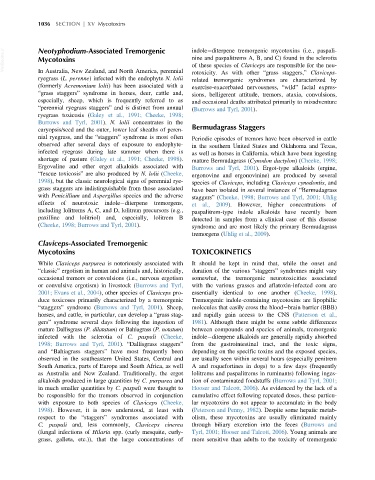Page 1104 - Veterinary Toxicology, Basic and Clinical Principles, 3rd Edition
P. 1104
1036 SECTION | XV Mycotoxins
VetBooks.ir Neotyphodium-Associated Tremorgenic indole diterpene tremorgenic mycotoxins (i.e., paspali-
nine and paspalitrems A, B, and C) found in the sclerotia
Mycotoxins
of these species of Claviceps are responsible for the neu-
In Australia, New Zealand, and North America, perennial
ryegrass (L. perenne) infected with the endophyte N. lolii rotoxicity. As with other “grass staggers,” Claviceps-
related tremorgenic syndromes are characterized by
(formerly Acremonium lolii) has been associated with a exercise-exacerbated nervousness, “wild” facial expres-
“grass staggers” syndrome in horses, deer, cattle and, sions, belligerent attitude, tremors, ataxia, convulsions,
especially, sheep, which is frequently referred to as and occasional deaths attributed primarily to misadventure
“perennial ryegrass staggers” and is distinct from annual (Burrows and Tyrl, 2001).
ryegrass toxicosis (Galey et al., 1991; Cheeke, 1998;
Burrows and Tyrl, 2001). N. lolii concentrates in the Bermudagrass Staggers
caryopsis/seed and the outer, lower leaf sheaths of peren-
nial ryegrass, and the “staggers” syndrome is most often Periodic episodes of tremors have been observed in cattle
observed after several days of exposure to endophyte- in the southern United States and Oklahoma and Texas,
infected ryegrass during late summer when there is as well as horses in California, which have been ingesting
shortage of pasture (Galey et al., 1991; Cheeke, 1998). mature Bermudagrass (Cynodon dactylon)(Cheeke, 1998;
Ergovaline and other ergot alkaloids associated with Burrows and Tyrl, 2001). Ergot-type alkaloids (ergine,
“fescue toxicosis” are also produced by N. lolii (Cheeke, ergonovine and ergonovinine) are produced by several
1998), but the classic neurological signs of perennial rye- species of Claviceps, including Claviceps cynodontis, and
grass staggers are indistinguishable from those associated have been isolated in several instances of “Bermudagrass
with Penicillium and Aspergillus species and the adverse staggers” (Cheeke, 1998; Burrows and Tyrl, 2001; Uhlig
effects of neurotoxic indole diterpene tremorgens, et al., 2009). However, higher concentrations of
including lolitrems A, C, and D, lolitrem precursors (e.g., paspalitrem-type indole alkaloids have recently been
paxilline and lolitriol) and, especially, lolitrem B detected in samples from a clinical case of this disease
(Cheeke, 1998; Burrows and Tyrl, 2001). syndrome and are most likely the primary Bermudagrass
tremorgens (Uhlig et al., 2009).
Claviceps-Associated Tremorgenic
Mycotoxins TOXICOKINETICS
While Claviceps purpurea is notoriously associated with It should be kept in mind that, while the onset and
“classic” ergotism in human and animals and, historically, duration of the various “staggers” syndromes might vary
occasional tremors or convulsions (i.e., nervous ergotism somewhat, the tremorgenic neurotoxicities associated
or convulsive ergotism) in livestock (Burrows and Tyrl, with the various grasses and aflatoxin-infected corn are
2001; Evans et al., 2004), other species of Claviceps pro- essentially identical to one another (Cheeke, 1998).
duce toxicoses primarily characterized by a tremorgenic Tremorgenic indole-containing mycotoxins are lipophilic
“staggers” syndrome (Burrows and Tyrl, 2001). Sheep, molecules that easily cross the blood brain barrier (BBB)
horses, and cattle, in particular, can develop a “grass stag- and rapidly gain access to the CNS (Patterson et al.,
gers” syndrome several days following the ingestion of 1981). Although there might be some subtle differences
mature Dallisgrass (P. dilatatum) or Bahiagrass (P. notatum) between compounds and species of animals, tremorgenic
infected with the sclerotia of C. paspali (Cheeke, indole diterpene alkaloids are generally rapidly absorbed
1998; Burrows and Tyrl, 2001). “Dallisgrass staggers” from the gastrointestinal tract, and the toxic signs,
and “Bahiagrass staggers” have most frequently been depending on the specific toxins and the exposed species,
observed in the southeastern United States, Central and are usually seen within several hours (especially penitrem
South America, parts of Europe and South Africa, as well A and roquefortines in dogs) to a few days (frequently
as Australia and New Zealand. Traditionally, the ergot lolitrems and paspalitrems in ruminants) following inges-
alkaloids produced in large quantities by C. purpurea and tion of contaminated foodstuffs (Burrows and Tyrl, 2001;
in much smaller quantities by C. paspali were thought to Hooser and Talcott, 2006). As evidenced by the lack of a
be responsible for the tremors observed in conjunction cumulative effect following repeated doses, these particu-
with exposure to both species of Claviceps (Cheeke, lar mycotoxins do not appear to accumulate in the body
1998). However, it is now understood, at least with (Peterson and Penny, 1982). Despite some hepatic metab-
respect to the “staggers” syndromes associated with olism, these mycotoxins are usually eliminated mainly
C. paspali and, less commonly, Claviceps cinerea through biliary excretion into the feces (Burrows and
(fungal infections of Hilaria spp. (curly mesquite, curly- Tyrl, 2001; Hooser and Talcott, 2006). Young animals are
grass, galleta, etc.)), that the large concentrations of more sensitive than adults to the toxicity of tremorgenic

